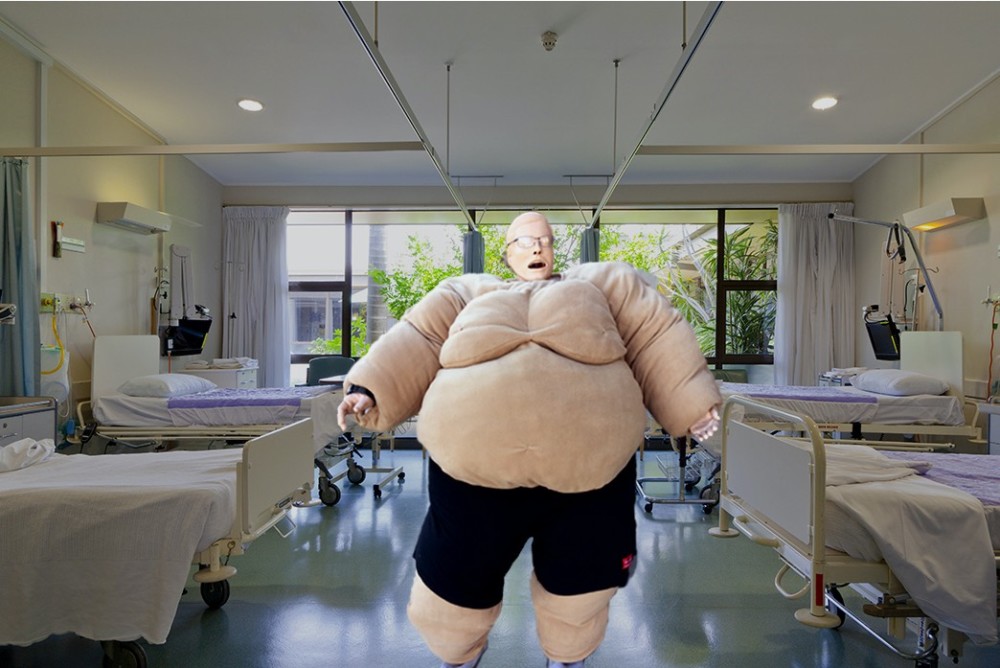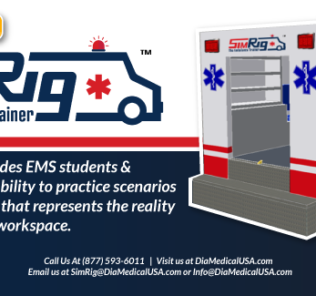Bariatric Simulators Provide Plus-Sized Patient Surgical & Patient Care Training
A bariatric simulator is a segmented clinical task trainer that represents a bariatric patient and that can be used to teach surgical skills or patient movement for EMS, PT, or other direct patient care professionals. Surgical learners can gain valuable practice experience and insight while performing various bariatric surgical procedures through the use of bariatric simulation. For other professional healthcare providers, learning how to move obese patients is critical to both the safety of the patient and provider. Especially for EMS providers, learning how to physically move a patient with other care providers during emergency situations ahead of time through medical simulation can literally save lives.
As laparoscopic bariatric surgery operations can be technically challenging and their training opportunities for junior surgeons limited, using virtual reality simulation can be an especially effective alternative to completing the training and assessment of laparoscopic bariatric technical skills. Virtual reality bariatric simulation scenarios provide learners with the opportunity to develop the necessary critical thinking skills to maintain care for this patient population.
There are currently a number of commercially available bariatric simulation products for a variety of skills practices. They can be used to visually train on bariatric pulmonary challenges, sensitivity, mobility, fall risk, and skin safety. Bariatric transport, another element of care that can prove challenging, can be simulated to prepare learners as well. Together, training of these skills and procedures can help bridge the gap between introductory clinical simulation training and actual clinical practice.
Sponsored Content:
Pocket Nurse Bariatric Simulation Products
Pocket Nurse offers a number of products that either represent obese patients or the accessories used to treat them. For example, SimObesity product solutions are designed to simulate the unique physical complexities of caring for bariatric patients. The SimObesity Shirt is constructed to go over healthcare simulation manikins or standardized patients to simulate obesity. The shirt exposes learners to the complex physical and emotional challenges of providing healthcare to this population. Alternatively, the SimObesity Shirt Jr. is constructed to fit over pediatric manikins or standardized patients to simulate obesity. SimLeggings are clinical simulation accessories that are designed to zip over the ankles and lower legs of manikins from various manufacturers and can also be worn by standardized patients.
SimObesity Bariatric Simulation Shirt
The SimObesityShirt, available from vendors like Pocket Nurse, Nasco Simulaids, or DiaMedical is a bariatric simulator that fits adult mannequins from all major suppliers as well as standardized patients, learners, and instructors. The weighted, pendulous breasts and pannus create deep skin folds, into which pills, simulated yeast or fungus, and other items can be placed. Weighted pannus provides realistic catheterization challenges, and the large upper arm size makes learners assess the appropriate blood pressure cuff size needed.
Sponsored Content:
The shirt provides realistic challenges to listening to heart and chest sounds, making learners lift the breasts to obtain more direct contact with the chest wall for clearer sounds. The bariatric shirt further contains bilateral deltoid injection sites and an abdominal site for subcutaneous injections. The product includes all padding and weights needed for realism, as well as a fully washable “skin” and storage bag.
InSimo’s Bariatric Simulation Education Module
InSimo, a surgical simulation software company, creates the InSimo Bariatric Surgery Simulation Modules that allow learners to take care of a virtual patient suffering from morbid obesity. Using the company’s curriculum, they can then determine the best bariatric procedures to treat their patients.
This technology is both scalable and interactive, and the module is a great educational tool and resource for those learning how to perform bariatric surgery. Using the platform, learners are able to react to surgical interactions on the display system through the biomechanical simulation presented. They can test, measure and visualize the consequences of different surgical strategies on this virtual patient, and learn how to choose the best approach without any risks.
Ideal for animated tutorials, the InSimo curriculum enables learners to examine a clinical case and to plan a surgery step-by-step to understand all of the risks. Elements of surgery covered by these courses include being able to determine the best procedure by studying the patient’s anatomy, to perform an endoscopic sleeve gastroplasty, to undertake a sleeve gastrectomy, and determining whether to install a gastric band.
An example of an available curriculum course is the “Virtual Surgery: 1st Trial,” where the learner will perform their first virtual surgery trial by applying a pattern of sutures the inner wall of the stomach to significantly reduce its volume. Next, during a “Ranking Exercise,” they can visualize and compare different proposed surgical results, then try to rank them from best to worst. The “Virtual Surgery: 2nd Trial” course is where learners will again perform a virtual surgery on a virtual patient, to try and improve upon the results from their first trial.
Through these simulation solutions, educators can also use patient data to create a curriculum suited to their educational needs. The company’s bariatric surgery module has been developed alongside health professionals and is based on a patient-specific anatomy.
KindHeart Bariatric Surgery Simulator
The KindHeart Bariatric Surgery Simulator is a porcine model containing diaphragm, esophagus, stomach, liver, spleen, gallbladder, duodenum, small bowel, omentum and short gastric vessels. A pre-placed bougie dilator is included, and the stomach is modified to allow stapling of full thickness with green or black loads. This model can be used to demonstrate a sleeve gastrectomy, a “Roux-en-Y” gastric bypass, and a gastrojejunostomy.
KindHeart Tissue Cassettes are shipped vacuum-sealed and should be kept refrigerated below 40°F (4°C) or frozen at 0°F (-18°C). Shelf life is 30 days refrigerated or 6 months frozen. This model includes a simple 5-minute setup and a drip-free cleanup with an integrated disposal bag. All KindHeart Tissue Cassettes are nonhazardous and can be disposed of in black bags.
SIM U SUIT Bariatric Simulation Training Solutions
SIM U SUIT has developed bariatric suits, obesity suits, pediatric obesity suits, edema arm sleeves, edema leggings, and other products that can be applied to simulation mannequins or real people. These bariatric products are constructed of sturdy materials and reinforced frames to accommodate high-weight-capacity needs, and offer durability and stability. The company’s products can be used by educators and learners involved in medical and bariatric simulation education and training. Caring for obese, bariatric and overweight patients requires proper training and consideration to ensure both the patient’s safety and that of the healthcare provider.
Obesity suits designed by SIM U SUIT allow users to simulate true-to-life size, look, and weight of bariatric patients. The suits can be worn by real people, or used on mannequins and human patient simulators. These products provide learners with the ability to add weight to meet their specific educational objectives. Learners can make the suit as heavy or light as their scenarios require.
DiaMedical USA offers a wide variety of right-sized, high-capacity Sim U Suit bariatric medical equipment to meet the needs of even the largest patients. DiaMedical USA additionally distributes specialized bariatric hospital beds, bariatric mobility products (such as walkers and wheelchairs), bariatric mattresses and more.
These products enable educators to teach the safe and proper care for the growing number of overweight patients in the healthcare system. Today, SIM U SUIT products are used all over the world by nursing schools, hospitals, medical personnel, military personnel, EMS, fire departments, colleges, universities, public health officials, and other entities who are engaged in medical education and bariatric patient training.
Bariquins Bariatric Simulation Manikins
Bariquins, a healthcare simulation company, has developed a plus-size mannequin training aid known as a “Bariquin.” ‘Barry’ as the original product is known, weighs 350 pounds and is easy to disassemble, move and store. Barry has been designed to assist the manual-handling training of healthcare workers, emergency personnel and many others so they can safely and efficiently maneuver or rescue plus-size patients.
Produced in the United Kingdom, Bariquin requires only one instructor — not a team — to take it to the location where teaching will be held.. There is no need to purchase industrial lifting equipment or chance using an insufficient number of trainers, as the heaviest component of a Bariquin weighs only a little more than 35 pounds.
Bariquins have flexible limbs similar to a real person’s, and its realistic looking head, hands and feet help trainees react like they are dealing with an actual patient. The product’s weight is distributed throughout the body and limbs, not concentrated in one heavy, unrealistic mass.
They’re manufactured to a high quality and have a superior look to them, reflecting the professionalism of the organizations using them. The product can be used in demanding scenarios because they are made of impact-resistant material, heavy-duty fittings and robust manufacturing methods. Bariquins are designed to be quickly set up before training through a system of decals and connector markings. After training, they can be even more quickly taken apart and stored away easily when not in use.
Find Your Ideal Simulation Bariatric Vendors Now!
Lance Baily, BA, EMT-B, is the Founder / CEO of HealthySimulation.com, which he started in 2010 while serving as the Director of the Nevada System of Higher Education’s Clinical Simulation Center of Las Vegas. Lance also founded SimGHOSTS.org, the world’s only non-profit organization dedicated to supporting professionals operating healthcare simulation technologies. His co-edited Book: “Comprehensive Healthcare Simulation: Operations, Technology, and Innovative Practice” is cited as a key source for professional certification in the industry. Lance’s background also includes serving as a Simulation Technology Specialist for the LA Community College District, EMS fire fighting, Hollywood movie production, rescue diving, and global travel. He and his wife live with their two brilliant daughters and one crazy dachshund in Las Vegas, Nevada.
Sponsored Content:


















